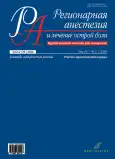Пропофол и послеоперационная боль. Время менять приоритеты?
- Авторы: Овечкин А.М.1
-
Учреждения:
- ФГАОУ ВО «Первый московский государственный медицинский университет им. И.М. Сеченова» (Сеченовский университет)
- Выпуск: Том 14, № 3 (2020)
- Страницы: 118-120
- Раздел: Редакционная статья
- URL: https://journals.rcsi.science/1993-6508/article/view/57658
- DOI: https://doi.org/10.17816/1993-6508-2020-14-3-118-120
- ID: 57658
Цитировать
Аннотация
В настоящее время применение ингаляционных анестетиков является базовым методом общей анестезии. Тотальная внутривенная анестезия (ТВА) на основе пропофола мало распространена. Однако на протяжении последних лет получены данные доказательной медицины о снижении интенсивности послеоперационной боли и потребности в анальгетиках у пациентов, оперированных в условиях ТВА на основе пропофола, по сравнению с ингаляционной анестезией. Возможно, что этот факт явится основой для пересмотра схем общей анестезии.
Ключевые слова
Полный текст
Открыть статью на сайте журналаОб авторах
А. М. Овечкин
ФГАОУ ВО «Первый московский государственный медицинский университет им. И.М. Сеченова» (Сеченовский университет)
Автор, ответственный за переписку.
Email: ovechkin_alexei@mail.ru
ORCID iD: 0000-0002-3453-8699
д. мед. н., профессор кафедры анестезиологии и реаниматологии
Россия, МоскваСписок литературы
- Chan A., Qiu Q., Choi S.W., Wong S.S.C.,Chan A.C.Y.,Irwin M.G. et al. Effects of intra-operative total intravenous anaesthesia with propofol versus inhalational anaesthesia with sevoflurane on post-operative pain in liver surgery: a retrospective case-control study // PLoS One. 2016. Vol. 11. N 2. e0149753. DOI: https://doi.org/10.1371/journal.pone.0149753.
- Ogurlu M., Sari S., Kucuk M., Bakis M., Uguir B.,Eshraghi Y.E. et al. Comparison of the effect of propofol and sevoflurane anaesthesia on acute and chronic postoperative pain after hysterectomy // Anaesth Intensive Care. 2014. Vol. 42. N 3. P. 365–370. DOI: https://doi.org/10.1177/0310057X1404200314.
- Li M., Mei W., Wang P, Yu Y., Qian W., Zhang Z.G. et al. Propofol reduces early post-operative pain after gynecological laparoscopy // Acta Anaesthesiol Scand. 2012. Vol. 56. N 3. P. 368–375. doi: 10.1111/j.1399-6576.2011.02603.x.
- Qiu Q., Choi S., Wong S. Irwin M.G., Cheung C.W. Effects of intra-operative maintenance of general anaesthesia with propofol on postoperative pain outcomes: a systematic review and meta-analysis // Anaesthesia. 2016. Vol. 71. P. 1222–1233. DOI: https://doi.org/10.1111/anae.13578.
- Peng K., Liu H-Y., Wu S-R., Liu H., Zhang Z-C., Ji F-H. Does propofol anesthesia lead to less postoperative pain compared with inhalational anesthesia? A systematic review and meta-analysis // Anesth Analg. 2016. Vol. 123. N 4. P. 846–858. DOI: https://doi.org/10.1213/ANE.0000000000001504.
- Song J., Shin J., Lee E., Choi D.K., Bang J.Y., Chin J.H.C. et al. Incidence of post-thoracotomy pain: a comparison between total intravenous anaesthesia and inhalation anaesthesia. Eur J. Cardiothorac Surg. 2012. Vol. 41. N 5. P. 1078–1082. DOI: https://doi.org/10.1093/ejcts/ezr133.
- Zhang Y., Eger E., Dutton R., Sonner J.M. Inhaled anesthetics have hyperalgesic effects at 0.1 minimum alveolar anesthetic concentration // Anesth Analg. 2000. Vol. 91. N 2. P. 462–466. DOI: https://doi.org/10.1097/00000539-200008000-00044.
- Rowley T., Daniel D., Flood P. The role of adrenergic and cholinergic transmission in volatile anesthetic-induced pain enhancement // Anesth Analg. 2005. Vol. 100. N 4. P. 991–995. DOI: https://doi.org/10.1213/01.ane.0000147708.73945.b3.
- O’Connor T., Abram S. Inhibition of nociception-induced spinal sensitization by anesthetic agents. // Anesthesiology. 1995. Vol. 82. P. 259–266. DOI: https://doi.org/10.1097/00000542-199501000-00031.
- Bandschapp O., Filitz J., Ihmsen H., Berset A., Urwyler A. Koppert W. et al. Analgesic and antihyperalgesic properties of propofol in a human pain model // Anesthesiology. 2010. Vol. 113. P. 421–428. DOI: https://doi.org/10.1097/ALN.0b013e3181e33ac8.
- Chen R., Chen T., Chen T., Lin L.-L.,Chang C.-C., Chang H.-C. et al. Anti-inflammatory and antioxidative effects of propofol on lipopolysaccharide-activated macrophages // Ann N Y Acad Sci. 2005. Vol. 1042. P. 262–271. DOI: https://doi.org/10.1196/annals.1338.030.
- Zhao M., Joo D. Enhancement of spinal N-methyl-D-aspartate receptor function by remifentanil action at delta-opioid receptors as a mechanism for acute opioid-induced hyperalgesia or tolerance // Anesthesiology. 2008. Vol. 109 P. 308–317. DOI: https://doi.org/10.1097/ALN.0b013e31817f4c5d.
- Kotani Y., Shimazawa M., Yoshimura S., Iwama T., Hara H. The experimental and clinical pharmacology of propofol, an anesthetic agent with neuroprotective properties // CNS NeurosciTher. 2008. Vol. 14. P. 95–106. DOI: https://doi.org/10.1097/ALN.0b013e31817f4c5d.
- Singler B., Troster A., Manering N., Schuttler J., Koppert W. Modulation of remifentanil-induced postinfusion hyperalgesia by propofol // Anesth Analg. 2007. Vol. 104. N 6. P. 1397–1403. DOI:https://doi.org/10.1213/01.ane.0000261305.22324.f3.
- Pandit J., Andrade J., Bogod D., Hitchman J., Jonker W., Lucas N. et al. 5th National Audit Project (NAP5) on accidental awareness during general anaesthesia: summary of main findings and risk factors // Br J Anaesth. 2014. Vol. 113. P. 549–559. DOI: https://doi.org/10.1093/bja/aeu313.
Дополнительные файлы






